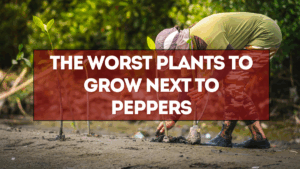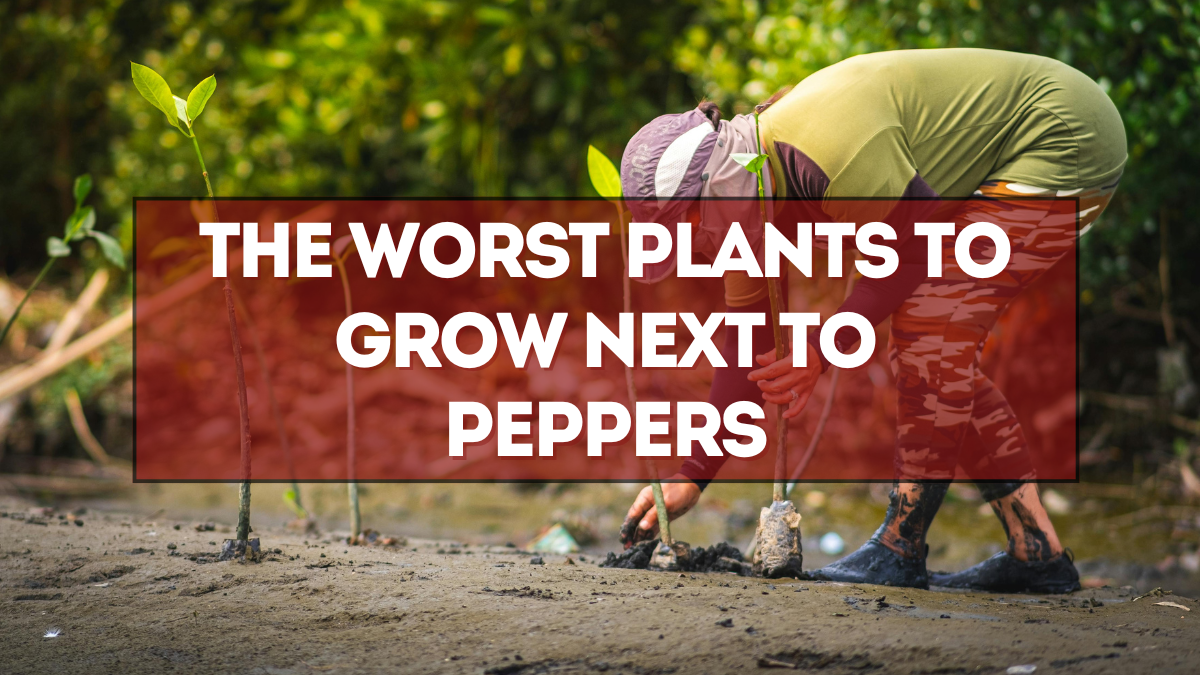Peppers are a staple in home gardens, loved for their vibrant fruits, variety of heat levels, and ability to thrive in warm conditions. Whether you’re growing sweet bell peppers or spicy chilies, companion planting can make or break your harvest. While some plants help peppers grow stronger, others can stunt their growth, attract pests, or compete for nutrients. Knowing the worst plants to grow next to peppers—and the right alternatives—will ensure healthier plants and higher yields.
This guide explains which neighbors to avoid, why they cause problems, and which companion plants you should grow instead. By following these principles of companion planting, you’ll keep your pepper plants thriving all season long.

Why Companion Planting Matters for Peppers
Companion planting is the practice of arranging crops in a way that benefits each other. Some plants improve soil nutrients, attract pollinators, or repel pests. Others, however, create the opposite effect through allelopathy (chemical inhibition), pest attraction, or nutrient competition.
Peppers are moderately demanding plants that need plenty of sun, fertile soil, and consistent moisture. Bad neighbors can:
-
Steal nutrients like nitrogen or potassium
-
Shade peppers and reduce fruiting
-
Introduce harmful pests or diseases
-
Release chemicals that slow pepper growth
That’s why it’s crucial to avoid certain crops and instead pair peppers with beneficial companions.
Worst Plants to Grow Next to Peppers
1. Fennel
Fennel is one of the most problematic plants to grow near peppers or most other vegetables. It releases allelopathic chemicals into the soil, which suppress the growth of neighboring plants.
Why it’s harmful:
-
Stunts pepper root development
-
Reduces overall yield
-
Attracts certain pests that may attack peppers
Keep fennel in its own bed, far from your pepper patch.
2. Brassicas (Cabbage Family)
Members of the brassica family—like cabbage, broccoli, cauliflower, and kale—are heavy feeders that compete aggressively with peppers.
Problems they cause:
-
Compete for nitrogen and soil nutrients
-
Shade smaller pepper plants with broad leaves
-
Attract pests like aphids and cabbage worms that may also attack peppers
Instead, grow brassicas in a separate section of your garden.
3. Beans (Pole and Bush Beans)
Beans are often considered good companions for many crops, but not for peppers. Their vigorous growth habit can overwhelm delicate pepper plants.
Issues with beans:
-
Climbing beans can shade peppers and restrict airflow
-
They may attract aphids, spider mites, and beetles that can harm peppers
-
Roots may interfere with pepper root zones
If you do grow beans, keep them several rows away from your peppers.
4. Apricot Trees
This one surprises many gardeners: apricot trees are a poor companion for peppers. Growing peppers under apricots increases the risk of fungal diseases like rust.
Why it’s harmful:
-
Apricot trees release substances that encourage fungal growth
-
Shaded conditions under the tree reduce pepper yield
Keep fruit trees like apricot away from your vegetable patch.
5. Other Nightshades (Tomatoes, Eggplants, Potatoes)
Peppers belong to the nightshade family, and while they share growing conditions with tomatoes, eggplants, and potatoes, planting them together can backfire.
Problems include:
-
Increased risk of soil-borne diseases like blight and verticillium wilt
-
Shared pests such as aphids, hornworms, and flea beetles
-
Competition for similar nutrients
It’s better to rotate nightshades each season rather than clustering them together.
What to Plant Instead (Best Companions for Peppers)
Now that you know which plants to avoid, here are the best alternatives to grow near peppers for stronger plants and bigger harvests.
1. Basil
Basil is one of the top companions for peppers. Not only does it repel common pests, but it also enhances the flavor of pepper fruits.
Benefits:
-
Repels aphids, thrips, and mosquitoes
-
Attracts pollinators for better fruit set
-
Compact growth that won’t shade peppers
2. Marigolds
Marigolds are famous for their ability to repel nematodes and other soil-dwelling pests. They also add color and beauty to your pepper beds.
Benefits:
-
Natural pest deterrent
-
Attracts beneficial insects
-
Easy to grow alongside peppers
3. Onions and Garlic
Allium family plants like onions, garlic, and chives make excellent pepper companions.
Benefits:
-
Repel aphids, beetles, and spider mites
-
Take up little space in the soil
-
Don’t compete heavily for nutrients
4. Carrots
Carrots grow well with peppers because their root systems do not interfere with pepper roots.
Benefits:
-
Help break up soil, improving aeration
-
Utilize space efficiently under pepper plants
-
Easy to harvest alongside peppers
5. Spinach and Lettuce
Leafy greens like spinach and lettuce are great companions because they have shallow roots and grow quickly.
Benefits:
-
Provide ground cover to keep soil cool and moist
-
Do not compete heavily for nutrients
-
Mature quickly before peppers reach full size
6. Dill and Oregano
These herbs attract beneficial insects while enhancing the flavor of peppers in culinary use.
Benefits:
-
Attract predatory insects that control pests
-
Aromatic presence deters harmful bugs
-
Low-growing plants that won’t shade peppers
Companion Planting Layout for Peppers
To design an effective pepper garden:
-
Place basil and marigolds around the edges of pepper beds
-
Use onions or garlic between pepper rows as natural pest deterrents
-
Grow lettuce or spinach in shaded spots under taller peppers
-
Keep problematic crops like fennel, beans, and brassicas far away
This layout maximizes pest control, improves pollination, and keeps your pepper patch productive.
Common Mistakes in Pepper Companion Planting
-
Planting too many nightshades together, which spreads diseases quickly
-
Overcrowding with large brassicas that block light
-
Forgetting to rotate pepper locations season to season
-
Assuming all legumes are beneficial without checking specific crop interactions
By avoiding these mistakes, you’ll reduce the risk of poor harvests.
Why Alternatives Work Better
Companion planting isn’t just about avoiding bad neighbors—it’s about creating a system where plants actively support one another. The suggested alternatives provide pest resistance, nutrient balance, or soil improvements that bad neighbors simply can’t. Choosing smart companions will give you bigger, healthier peppers with fewer problems.
FAQs
Why shouldn’t I grow peppers near fennel?
Fennel releases chemicals into the soil that stunt pepper growth and reduce yield.
Can I grow peppers and tomatoes together?
It’s not ideal, as they share pests and diseases. If you do, rotate crops yearly and maintain good spacing.
Are beans always bad for peppers?
Beans compete for space and may shade peppers, but in larger gardens, keeping them a few rows apart minimizes issues.
What are the best plants to grow with peppers?
Basil, marigolds, onions, garlic, lettuce, spinach, and carrots are excellent choices.
How can I design a pepper-friendly garden?
Use pest-repelling herbs like basil around peppers, intercrop with shallow-rooted greens, and keep bad neighbors at a distance.
Click here to know more.
